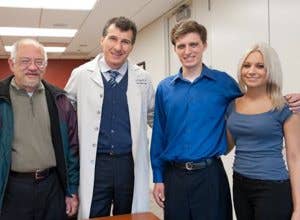Same Kidney Transplanted Twice

Share
Twenty-seven-year-old Ray Fearing suffered from focal segmental glomerulosclerosis (FSGS), a common type of kidney disease, and needed a new kidney. His 24-year-old sister, Cera Fearing, wanted to give him hers. The transplanted kidney immediately began to grow diseased, so doctors removed it. But then something happened that, according to the doctor who performed the procedure, had never been done before. The unhealthy kidney was removed and replanted into another patient, and the disease was reversed.
The second recipient, 67-year-old Erwin Gomez, is doing just fine with the new kidney.
In addition to affecting Ray, focal segmental glomerulosclerosis is also a common complication following kidney transplants, developing in 40 percent of kidney transplant recipients. Because of Ray’s preexisting condition doctors were extra cautious, monitoring the health of the kidney very closely. They saw signs that FSGS was developing within 24 hours of the surgery. Further testing confirmed that the disease had in fact taken hold and doctors therefore removed the kidney 14 days after it had been implanted.
The recipient then became the donor.
Erwin Gomez was suffering from end-stage renal disease brought on by type 2 diabetes. Dr. Lorenzo Gallon, the doctor at Chicago’s Northwestern University who performed the surgery, re-implanted Ray’s kidney into Gomez. Immediately the kidney showed a turn-around. Biopsies showed that the lesions caused by FSGS had been reversed and assessments showed normal filtration function. According to Dr. Gallon, such a reversal had never been seen.
The second transplant was performed on June 30 of last year. Ten months after receiving the re-implanted kidney, Gomez, a surgeon himself, is doing great. Meet the people in this remarkable story in the following video.
Be Part of the Future
Sign up to receive top stories about groundbreaking technologies and visionary thinkers from SingularityHub.


https://c.brightcove.com/services/viewer/federated_f9
As uplifting as the trio’s story is, the successful re-implantation may offer more in revealing something about the cause of focal segmental glomerulosclerosis. Researchers have theorized that it may be caused by a factor circulating in the bloodstream but have not yet confirmed the idea. But by transplanting the kidney into a FSGS patient, then re-transplanting it into a non-FSGS patient, they essentially performed an experiment testing the bloodborne theory. And the fact that the disease arose rapidly in Ray but vanished just as rapidly after Gomez received it supports the idea that it is caused by a circulating factor. Not only does this inform researchers about the cause of the disease, but it means doctors may not have to give up on many of the kidneys that develop FSGS after implantation, that they might also be successfully re-implanted in another patient.
While promising, stem cell therapies for renal failure don't appear to be a real solution anytime soon. Same goes for growing kidneys from scratch. But the current operation could prove huge for those in need of a kidney. Kidneys make up about 80 percent of transplanted organs. Even so, there are still 114,045 people waiting for a kidney. If doctors begin giving FSGS-“doomed” kidneys a second chance, it could make the difference between life and death for many.
[image credits: USA Today]
[video credit: USA Today]
images: kidney
video: kidney
Peter Murray was born in Boston in 1973. He earned a PhD in neuroscience at the University of Maryland, Baltimore studying gene expression in the neocortex. Following his dissertation work he spent three years as a post-doctoral fellow at the same university studying brain mechanisms of pain and motor control. He completed a collection of short stories in 2010 and has been writing for Singularity Hub since March 2011.
Related Articles

Data Centers in Space: Will 2027 Really Be the Year AI Goes to Orbit?

New Gene Drive Stops the Spread of Malaria—Without Killing Any Mosquitoes

These Robots Are the Size of Single Cells and Cost Just a Penny Apiece
What we’re reading
